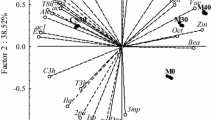Abstract
Wine elaborated from different white Galician varieties (32% Albariño grapes, 15% Treixadura grapes, 12% Loureira grapes, 8.2% Godello grapes and 32.8% Torrontés grapes) was divided in four lots. The wine was vinified traditionally and, after the alcoholic fermentation, the first lot was clarified, and the other three ones have stayed in contact with the natural lees and/or commercial lees. Aromatic composition, after 2 and 7 months, was evaluated by gas chromatographic and organoleptic analysis. Generally, all volatile compounds shown a significant increase after 2 months of contact with the lees, and also after 7 months. In the sensory analysis, the wine tasters rated the intensity of the seven aromatic descriptors (floral, fruity, grass, spice, wood, sulfurous and caramel) for each wine, and the long maturing time rebounds in a decrease of the floral and fruity aromas with respect to the model wine and in an increase in sulphurous character.

Similar content being viewed by others
References
Delteil D (2002) Austr Grapegrower Winemaker 461:104–108
Feuillat M (1992) Rev Fr Oenol 65:47–50
Guimberteau G (1995) Vitivinic 3–4:46–51
Vivas N, Nedjma M, Álvarez JM (2003) Rev ACE Enol 31:1–5 (http://www.acenologia.com/ciencia62_01.htm)
Bueno González-Tejero JE, Peinado Amores RA, Moreno Vigara JJ, Moyano Cañete L, Zea Calero L, Medina Carnicer M (2002) Vitic Enol Profes 82:55–56
Mauricio JC, Moreno J, Valero EM, Zea I, Medina M, Ortega JM (1993) J Agric Food Chem 41:2086–2091
Zea L, Moreno J, Medina M, Ortega JM (1994) J Ind Microbiol 13:269–272
Zea L, Moreno J, Medina M, Ortega JM, Mauricio JC, Medina M (1995) Biotechnol Lett 12:1351–1356
Ferrari G, Feuillat M (1988) Vitis 27:183–193
Molnar I, Oura E, Soumalainen H (1981) Acta Aliment 10:27–36
Zoecklein BW, Marcy JE, Jasinski Y (1997) Am J Enol Vitic 48:397–402
Postel W, Adams L (1987) Mitt Klostern 37:54–56
Feuillat M, Freyssinet M, Carpentier C (1989) Vitis 28:161–176
Palacios S, Varsserot Y, Maujean A (1997) Am J Enol Vitic 48:525–526
Bertrand A (1968) Utilisation de la chromatographie en phase gazeuse pour le dosage des constituants volatils du vin, Thése Docteur en Chimie, Univ. Bordeaux II
Bertrand A (1981). Formation des substances volatiles au cours de la fermentation alcoolique. Incidence sur la qualité du vin. Colloque Société Français de Microbiologie, Reims, pp 251–267
Chatonnet P, Boidron JN (1988) Sci Aliment 3:479–488
Norme ISO 3591 (1977) Sensory analysis. Apparatus Wine Tasting Glass
Ribéreau-Gayon P, Boidron JN, Terrier A (1975) J Agric Food Chem 23:1042–1047
Ollivier C, Stonestreet T, Larue F, Dubourdieu D (1987) Connais Vigne Vin 21:59–70
Carballeira Lois L, Cortés Diéguez S, Gil de la Peña ML, Fernández Gómez E (2001) Chromatographia 53:350–355
López R, Ferreira V, Cacho JF (1999) Quantitative determination of the odorants of young red wines from different grape varieties. In: TEC&DOC (ed) An assessment of their sensory role. 6° Symposium International d’Oenologie, Paris, pp 148–151
Peinado RA, Moreno J, Bueno JA, Mauricio JC (2004) Food Chem 84:585–590
Santamaría P, López R, Gutiérrez AR (1997) Vitic Enol Profes 50:12–17
Simpson RF (1979) Food Technol 31:516–522
Calderbank J, Hammond JR (1994) J Am Brew Chem 52:84–90
Etièvant PX (1991) In: Maarse H (ed) Wine; Volatile compounds in food and beverages. Marcel Decker, New York
Boidron JN, Chatonnet P, Pons M (1988) Connais Vigne Vin 22:275–294
Falqué E, Fernández E, Dubourdieu D (2001) Talanta 54:271–281
Falqué E, Fernández E, Dubourdieu D (2002) J Agric Food Chem 50:538–543
Estévez-Meléndez P, Gil de la Peña ML, Falqué E (2002) Cienc Tecnol Alim 3:223–228
Acknowledgements
The authors acknowledge the supply of sample wines by the Centro de Formación Profesional “A Granxa” of Puentareas (Pontevedra, Spain), and would like to thank the panel of wine tasters.
Author information
Authors and Affiliations
Corresponding author
Rights and permissions
About this article
Cite this article
Bautista, R., Fernández, E. & Falqué, E. Effect of the contact with fermentation-lees or commercial-lees on the volatile composition of white wines. Eur Food Res Technol 224, 405–413 (2007). https://doi.org/10.1007/s00217-006-0336-7
Received:
Revised:
Accepted:
Published:
Issue Date:
DOI: https://doi.org/10.1007/s00217-006-0336-7



